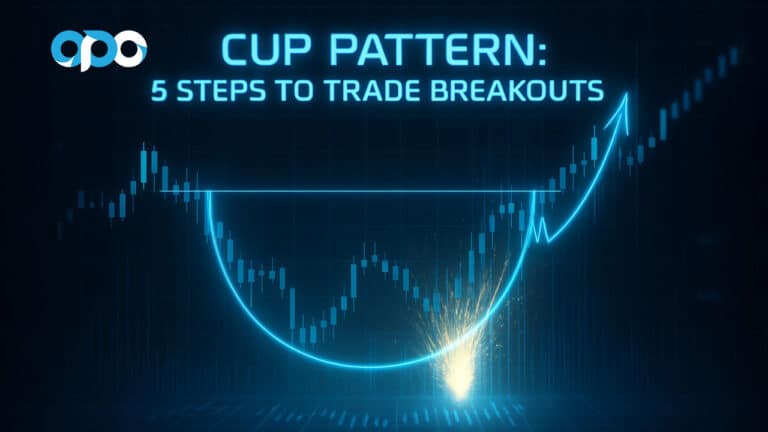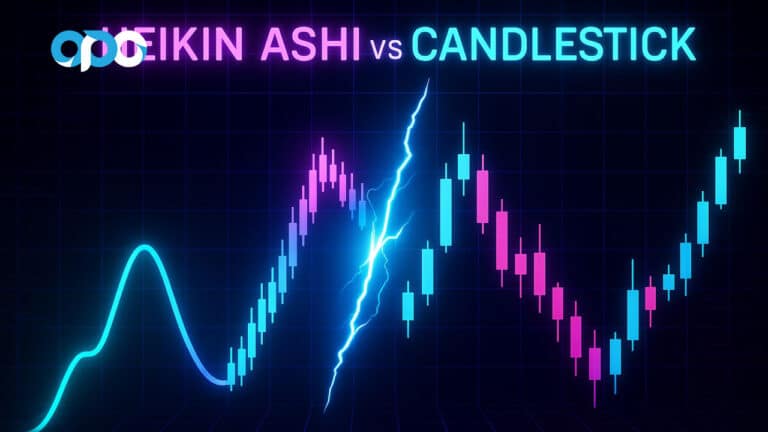The 5 EMA swing trading strategy is a technical analysis method that uses the 5-period Exponential Moving Average to identify profitable trading opportunities in the forex market. When seeking a regulated forex broker and an effective trading approach, this strategy stands out for its simplicity and effectiveness. The 5 EMA strategy works by helping traders identify short-term trend changes and momentum shifts, enabling them to make informed decisions about entering and exiting trades. As a popular technique among traders using online forex brokers, it combines the quick responsiveness of the 5-period EMA with price action analysis to potentially generate consistent profits in forex trading.
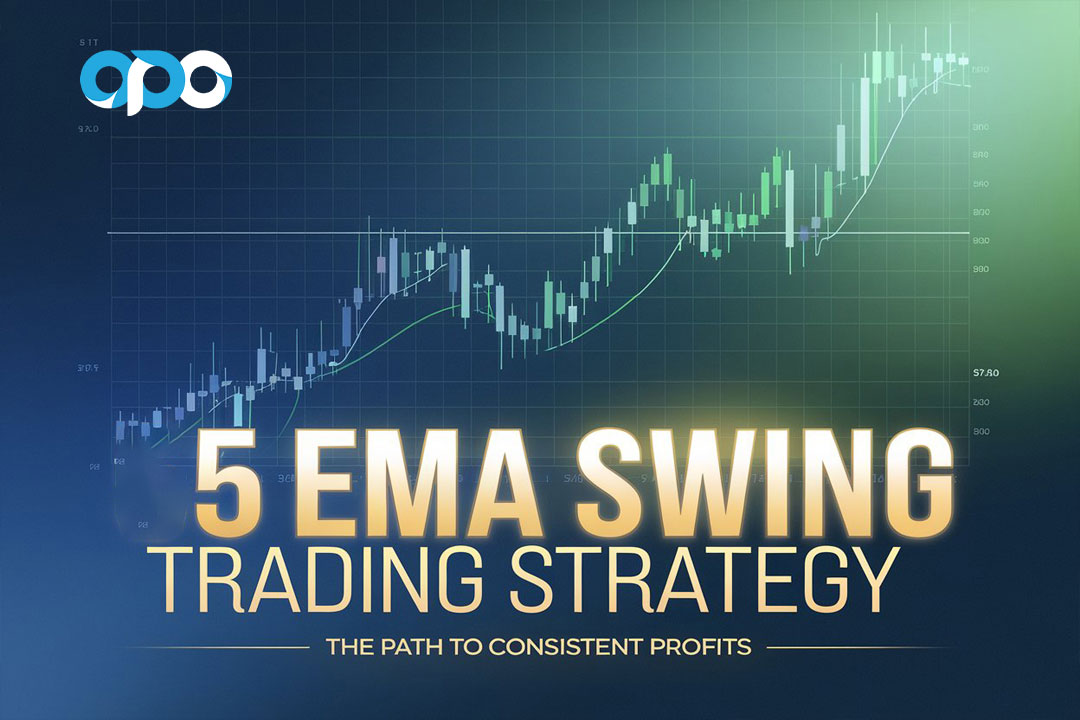
What Is the 5 EMA Swing Trading Strategy?
The 5 EMA swing trading strategy is a technical analysis approach that uses the 5-period Exponential Moving Average to identify short-term trend changes and potential trading opportunities. This strategy is particularly effective for swing traders who aim to capture price movements lasting several days to weeks. The 5 EMA responds quickly to price changes, making it an ideal tool for traders who want to stay ahead of market movements.
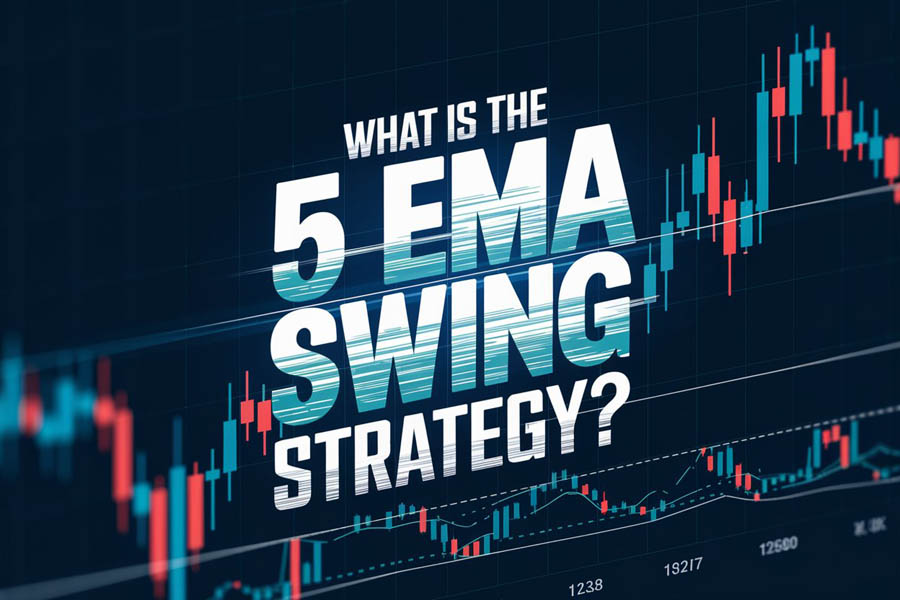
Mathematical Foundation of the 5 EMA
The 5 EMA is calculated using the following formula: EMA = Price(t) × k + EMA(y) × (1 − k) Where:
- t = today
- y = yesterday
- k = 2 ÷ (N + 1)
- N = number of periods (5 in this case)
This formula gives more weight to recent prices, making it more responsive to current market conditions compared to simple moving averages.
- 5 EMA Line:
- Acts as a dynamic support/resistance level, adjusting to price changes and providing real-time insights.
- Helps identify trend direction, allowing traders to gauge whether to enter long or short positions based on market momentum.
- Signals potential entry and exit points, offering clear indicators for when to act based on price movements relative to the EMA.
- Price Action:
- Candlestick patterns for confirmation, serving as visual representations of market sentiment and potential future movements.
- Important reversal patterns to watch:
- Engulfing patterns, indicating a strong shift in market sentiment and potential trend reversals.
- Doji candles, signifying indecision in the market and potential turning points.
- Hammer and Shooting Star formations, which highlight potential reversals after a price movement, providing critical insight for traders.
- Support and Resistance Levels:
- Historical price levels that have shown consistent behavior, helping traders anticipate future price movements.
- Psychological round numbers that often act as key barriers for price action, influencing trader behavior and decision-making.
- Previous swing highs and lows that provide context for current price levels, aiding in the identification of potential breakout or reversal zones.
- Volume:
- Confirms trend strength, as higher volume during price movements indicates stronger conviction in the direction of the trend.
- Helps identify potential reversals by showing divergences between price and volume, alerting traders to possible changes in market dynamics.
- Validates breakouts, ensuring that price movements are supported by sufficient trading activity, which is crucial for the sustainability of the new trend.
Read More: 55 EMA Swing Trading Strategy
How to Implement the 5 EMA Strategy
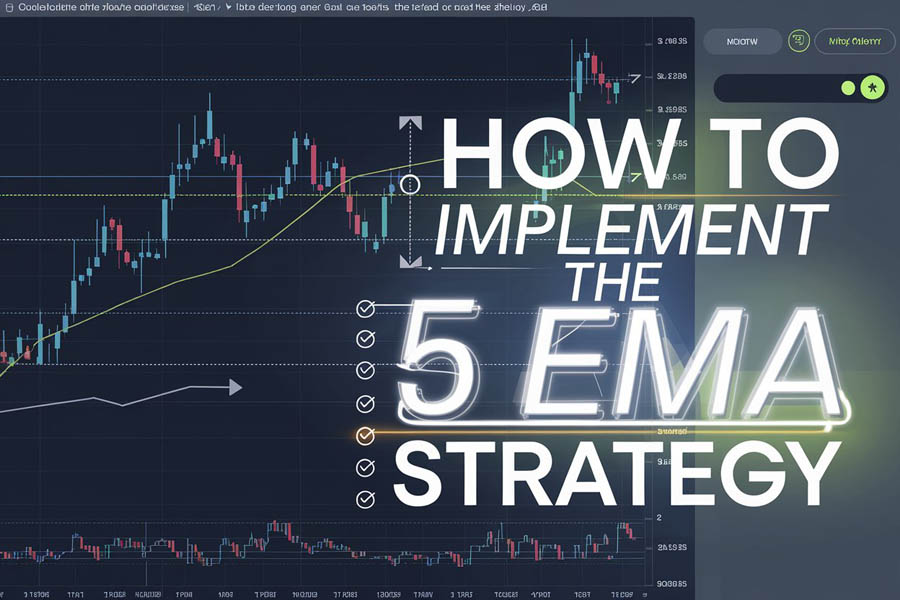
Step 1: Setting Up Your Charts
- Choose your preferred timeframe
- H4 (4-hour) benefits:
- Less noise than lower timeframes, allowing for clearer signals.
- Suitable for part-time traders, as it requires less frequent monitoring.
- Captures significant moves, providing ample opportunities for profit.
- Daily timeframe advantages:
- Reduces false signals, leading to more reliable trade setups.
- Better for longer-term trends, aligning with broader market movements.
- Often aligns with institutional trading, increasing the likelihood of successful trades.
- H4 (4-hour) benefits:
- Add the 5 EMA indicator
- Platform-specific instructions:
- MetaTrader 4/5: Insert > Indicators > Trend > Moving Average.
- TradingView: Indicators > Moving Average > Set to Exponential and Period 5.
- Platform-specific instructions:
- Identify key support and resistance levels
- Use multiple timeframe analysis to gain a comprehensive view of price action.
- Mark significant swing highs and lows, which can act as potential reversal points.
- Note round numbers (e.g., 1.3000, 1.3500) that often serve as psychological barriers.
Step 2: Entry Rules
Long Positions
- Price crosses above the 5 EMA
- Wait for candle close above the EMA to confirm the breakout.
- Look for strong momentum candles, indicating a robust trend.
- Avoid entering during ranging markets, as they can lead to false signals.
- Bullish candlestick patterns
- Engulfing patterns success rate: ~70%, indicating strong buying pressure.
- Hammer formations reliability: ~65%, suggesting potential reversals.
- Morning Star patterns accuracy: ~75%, providing additional confirmation for long entries.
- Volume confirmation
- Above-average volume preferred, as it indicates strong interest in the move.
- Look for rising volume on breakouts to validate the trend.
- Be cautious of low volume moves, which may lack sustainability.
Short Positions
- Price crosses below the 5 EMA
- Confirm with candle close below EMA to ensure the downtrend is established.
- Check for bearish momentum to support your decision to enter.
- Consider overall market sentiment, as it can influence trade outcomes.
- Bearish candlestick patterns
- Shooting Star reliability: ~68%, signaling potential reversals at resistance.
- Evening Star accuracy: ~72%, indicating a shift from bullish to bearish sentiment.
- Bearish Engulfing success rate: ~70%, confirming strong selling pressure.
Step 3: Exit Strategies
- Profit Targets
- Fixed pip targets (e.g., 50, 100, 150 pips) to ensure consistent profit-taking.
- Fibonacci extension levels for identifying potential reversal zones.
- Previous support/resistance levels, which can act as natural exit points.
- Stop Loss Placement
- Below/above recent swing points to protect against adverse movements.
- Using ATR for dynamic stops that adjust to market volatility.
- Percentage-based stops (1-2% of account) to manage risk effectively.
Read More: 50 EMA Swing Trading Strategy
Advanced Techniques
Multiple 5 EMA Strategy Variations
5 EMA Crossover with 20 EMA
- Entry signals:
- Crossover Confirmation: When the 5 EMA crosses above the 20 EMA, it signals a potential bullish trend. Conversely, a cross below indicates a bearish trend.
- Price Action Confirmation: Look for additional confirmation through candlestick patterns, such as bullish engulfing or hammer formations for long entries, and bearish engulfing or shooting stars for short entries.
- Success rate: ~65%, indicating a reliable strategy when combined with other technical indicators.
- Best timeframes: H4 and Daily, as they provide a balance between noise and trend clarity, allowing for more accurate signals.
- Example: If the 5 EMA crosses above the 20 EMA and a bullish engulfing pattern forms, consider entering a long position with a stop loss below the recent swing low.
5 EMA with RSI Strategy
- RSI settings: 14 period, commonly used to measure momentum and identify overbought/oversold conditions.
- Entry conditions:
- Price Above/Below 5 EMA: A price above the 5 EMA indicates bullish sentiment, while below suggests bearish sentiment.
- RSI Levels: Enter long positions when the RSI is above 50, confirming upward momentum. For shorts, enter when the RSI is below 50, indicating downward momentum.
- Additional filters:
- Avoid trades when RSI is overbought (above 70) or oversold (below 30), as these conditions can lead to potential reversals.
- Example: If the price is above the 5 EMA and the RSI is at 55, consider entering a long position. If the RSI approaches 70, it may be prudent to tighten stop losses or take partial profits.
5 EMA Pullback Strategy
- Identify Strong Trends: Wait for a clear uptrend or downtrend, identified by a series of higher highs and higher lows (for uptrends) or lower highs and lower lows (for downtrends).
- Enter on Pullbacks: Look for price to retrace to the 5 EMA during an established trend. This can provide a favorable entry point with a better risk-reward ratio.
- Confirm with Candlestick Patterns: Use patterns like pin bars or engulfing candles at the 5 EMA to confirm the validity of the pullback.
- Success rate: ~70% in strong trends, making this a highly effective strategy during trending markets.
- Example: In a strong uptrend, if the price pulls back to the 5 EMA and forms a bullish pin bar, enter a long position with a stop loss below the pin bar’s low.
Risk Management Deep Dive

Position Sizing Formula
- Risk Amount = Account Balance × Risk Percentage: Determine how much of your account you are willing to risk on a single trade (typically 1-2%).
- Position Size = Risk Amount ÷ Stop Loss in Pips: Calculate the number of lots to trade based on your risk amount and the distance of your stop loss.
- Example: If your account balance is $10,000 and you choose a risk percentage of 1%, your risk amount is $100. If your stop loss is 50 pips, your position size would be $100 ÷ 50 pips = 2 lots.
Risk-Reward Scenarios
- 1:1.5 – Conservative Approach: For every $1 risked, aim to make $1.50. This approach is suitable for traders who prefer to minimize risk and are comfortable with lower returns.
- 1:2 – Balanced Approach: Aiming for $2 in profit for every $1 risked strikes a good balance between risk and reward, appealing to many traders.
- 1:3 – Aggressive Approach: Targeting $3 for every $1 risked can lead to higher returns, but it also requires more stringent trade selection and discipline.
- Example: If you risk $100 on a trade with a target of $300 (1:3), ensure that your stop loss is placed appropriately to maintain this ratio.
Advanced Stop Loss Techniques
- Volatility-Based Stops Using ATR: Use the Average True Range (ATR) to set dynamic stop losses that adjust according to market volatility. For instance, if the ATR is 20 pips, set your stop loss 1.5 times the ATR (30 pips) from your entry point.
- Time-Based Stops: Exit trades after a specific duration (e.g., if a trade hasn’t reached the target within 3 days, consider closing it), especially in range-bound markets.
- Breakeven Strategies: Once a trade moves in your favor by a certain amount (e.g., 1:1 risk-reward), move your stop loss to breakeven to protect your capital. This allows you to ride potential larger moves without risking your initial investment.
- Example: If you enter a long position with a stop loss of 50 pips and the price moves in your favor by 50 pips, adjust your stop loss to your entry point to eliminate risk.
By incorporating these advanced techniques and robust risk management strategies, traders can enhance their trading performance and improve their chances of long-term success.
Read More: 200 EMA Swing Trading
Real-World Trading Scenarios
Scenario 1: EUR/USD Daily Timeframe
- Market Context:
- The market is in an uptrend on the daily timeframe, indicating a bullish environment and potential for upward price movement.
- Entry Setup:
- Pullback to 5 EMA: Price retraced to the 5 EMA, providing an optimal entry point for traders looking to capitalize on the trend.
- Bullish Engulfing Pattern: A bullish engulfing pattern formed at the 5 EMA, confirming strong buying interest and potential reversal.
- RSI Oversold Condition: The RSI showed an oversold condition (below 30), indicating a possible upward movement and reinforcing the bullish sentiment.
- Trade Management:
- Initial Stop Loss: Set at 50 pips to limit potential losses and protect capital.
- First Target: 100 pips profit target was hit, securing initial profits and validating the trade setup.
- Second Target: Aiming for 150 pips, which was also achieved, maximizing gains from the trade.
- Outcome:
- Total profit of +200 pips, demonstrating effective application of the strategy and risk management techniques.
- Key Lessons:
- Patience: Waiting for a pullback to improve entry quality is crucial for better risk-reward ratios.
- Multiple Confirmations: Utilizing various confirmation signals (candlestick patterns, RSI) strengthens trade decisions.
- Trailing Stop: Using a trailing stop effectively locks in profits as the trade moves in your favor.
Scenario 2: GBP/JPY 4-Hour Timeframe
- Market Context:
- The market is in a range-bound condition, requiring careful analysis and strategy for entries.
- Entry Setup:
- Break Above Range High: Price broke above the established range high, signaling a potential breakout opportunity.
- 5 EMA Angle: The 5 EMA exhibited a strong upward angle, indicating bullish momentum and supporting the breakout decision.
- Volume Confirmation: Increased volume confirmed the breakout, validating the trade setup and indicating strong market interest.
- Trade Management:
- Initial Stop Loss: Placed below the range low to protect against potential reversals and ensure risk management.
- Profit Target: Set at the previous resistance level for profit-taking, aligning with market structure.
- Outcome:
- Profit of +180 pips, showcasing successful execution of the strategy and effective trade management.
- Key Lessons:
- Range Breakout Strategies: These can be effective in consolidating markets, providing opportunities for traders.
- Volume Importance: The significance of volume in confirming breakouts cannot be overstated; it provides validation for trade setups.
- Realistic Targets: Setting achievable targets is crucial for consistent profitability, especially in volatile environments.
Market Conditions Analysis
Trading in Different Volatility Environments
- High Volatility Markets:
- Adjust Stop Losses: Use wider stop losses to accommodate larger price swings, reducing the risk of being stopped out prematurely.
- Reduce Position Size: Lower position sizes to manage risk effectively and protect capital in volatile conditions.
- Stronger Confirmation Signals: Look for more robust confirmation signals (e.g., multiple indicators aligning) to ensure trade validity before entering.
- Low Volatility Markets:
- Focus on Range-Trading Strategies: Capitalize on smaller price movements within established ranges, taking advantage of low volatility.
- Patience with Entries: Be patient, as opportunities may take longer to materialize in subdued market conditions.
- Shorter Profit Targets: Consider setting shorter profit targets to adapt to the lower price movement and ensure consistent gains.
Best Currency Pairs for 5 EMA Strategy
- EUR/USD:
- Average Daily Range: 80-100 pips, providing ample movement for trading opportunities.
- Best Times to Trade: 8:00-16:00 GMT, aligning with peak market activity and liquidity.
- GBP/USD:
- Average Daily Range: 100-120 pips, offering higher volatility suitable for traders looking for significant price movements.
- Considerations: More volatile, requiring wider stops to accommodate price fluctuations and protect against false signals.
- USD/JPY:
- Average Daily Range: 70-90 pips, making it suitable for traders focusing on the Asian session.
- Trading Strategy: Utilize the 5 EMA strategy effectively during the active hours of the Asian market for optimal results.
By applying these real-world scenarios and understanding market conditions, traders can refine their strategies and enhance their overall trading performance.
Opofinance Services

When implementing the 5 EMA swing trading strategy, choosing the right broker is crucial. Opofinance, an ASIC-regulated forex broker, offers traders a secure and professional trading environment. Their social trading service allows users to connect with experienced traders and copy their strategies, including successful 5 EMA implementations. As an officially featured broker on the MT5 brokers list, Opofinance provides:
- Competitive spreads starting from 0.6 pips
- Ultra-fast execution speeds under 0.1 seconds
- Safe and convenient deposits and withdrawals with multiple options
- Advanced MT4 and MT5 trading platforms
- Professional 24/5 customer support
- Educational resources and webinars on strategies like 5 EMA trading
Conclusion
The 5 EMA swing trading strategy offers a powerful approach to forex trading when implemented correctly. By following the guidelines outlined in this comprehensive guide and choosing a reliable broker like Opofinance, you can potentially improve your trading results. Remember to practice proper risk management and continuously refine your strategy based on market conditions. With dedication, discipline, and the right tools, the 5 EMA strategy can become a valuable addition to your trading arsenal.
Can the 5 EMA strategy be used for scalping?
While primarily designed for swing trading, the 5 EMA can be adapted for scalping on lower timeframes. However, traders should be aware that shorter timeframes may generate more false signals and require quicker decision-making.
How does the 5 EMA strategy perform during high volatility events?
During high volatility events, the 5 EMA may generate more false signals. It’s recommended to adjust your position sizing and potentially use wider stops during these periods to accommodate increased market movement.
What’s the ideal account size for using the 5 EMA strategy?
The 5 EMA strategy can be used with various account sizes, but a minimum of $1,000 is recommended to allow for proper position sizing and risk management. Smaller accounts may still use the strategy but should be extra cautious with position sizing.





